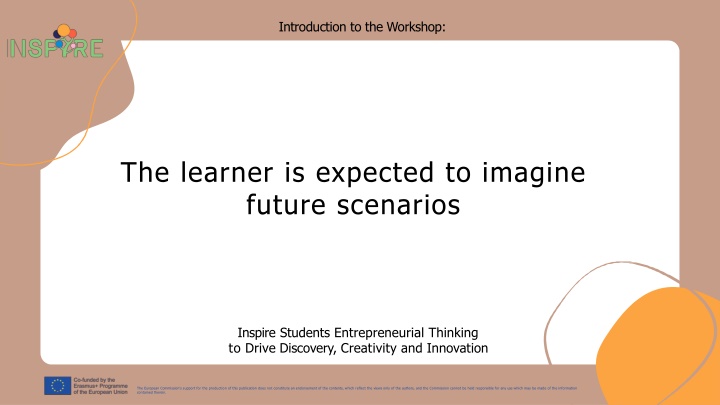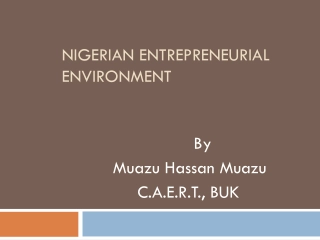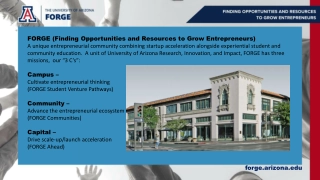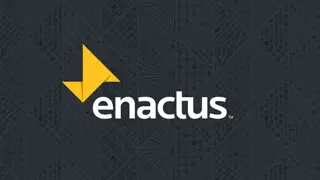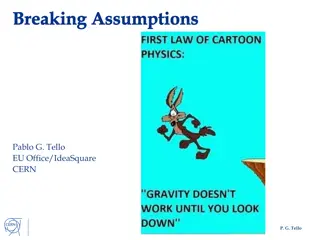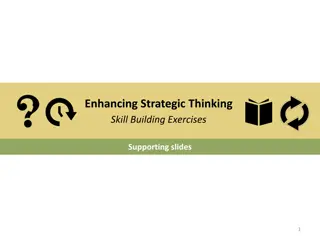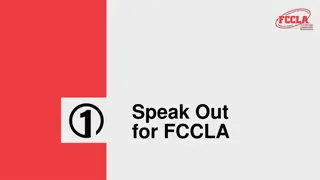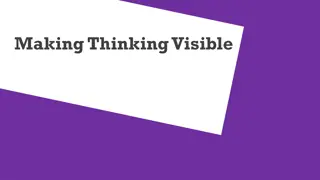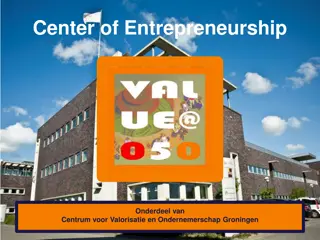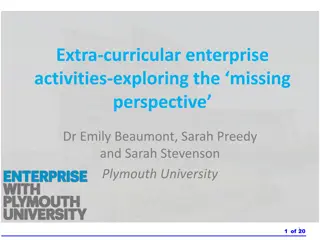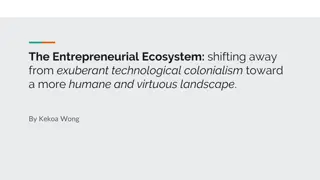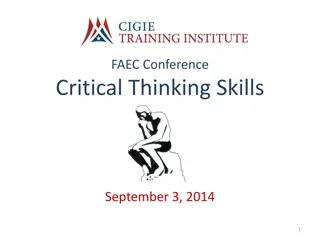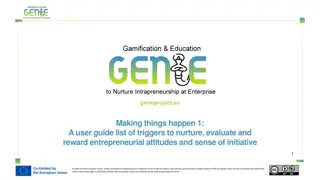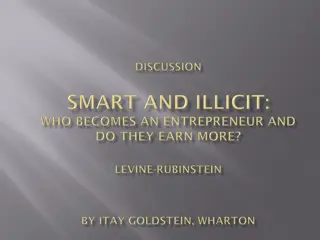Inspiring Entrepreneurial Thinking for Future Scenarios
Engage in a workshop focused on igniting students' entrepreneurial mindset to drive discovery, creativity, and innovation. Explore the use of event scenarios and business models to envision future possibilities and strategize for uncertainty in the environment. Join us in preparing for dynamic changes in the business landscape
Download Presentation

Please find below an Image/Link to download the presentation.
The content on the website is provided AS IS for your information and personal use only. It may not be sold, licensed, or shared on other websites without obtaining consent from the author.If you encounter any issues during the download, it is possible that the publisher has removed the file from their server.
You are allowed to download the files provided on this website for personal or commercial use, subject to the condition that they are used lawfully. All files are the property of their respective owners.
The content on the website is provided AS IS for your information and personal use only. It may not be sold, licensed, or shared on other websites without obtaining consent from the author.
E N D
Presentation Transcript
Introduction to the Workshop: The learner is expected to imagine future scenarios Inspire Students Entrepreneurial Thinking to Drive Discovery, Creativity and Innovation The European Commission's support for the production of this publication does not constitute an endorsement of the contents, which reflect the views only of the authors, and the Commission cannot be held responsible for any use which may be made of the information contained therein.
The learner is expected to imagine future scenarios Learning Outcomes to be Covered - recognize the potential of different possibilities, - classify these possibilities according to the potential - prepare a path to solution for different possible scenarios The European Commission's support for the production of this publication does not constitute an endorsement of the contents, which reflect the views only of the authors, and the Commission cannot be held responsible for any use which may be made of the information contained therein.
The learner is expected to imagine future scenarios This workshop covers 2 activities. The first activity Short concerns the use of scenarios based on business models and their construction. Tools supporting the Introduction creation of scenarios using business models will be discussed later. The European Commission's support for the production of this publication does not constitute an endorsement of the contents, which reflect the views only of the authors, and the Commission cannot be held responsible for any use which may be made of the information contained therein.
The learner is expected to imagine future scenarios What is a possible event scenario? It is a method of analyzing discontinuous changes, used in the conditions of a changing and unstructured environment. The scenario aims to indicate the range of volatility in which the future is most likely to lie. The European Commission's support for the production of this publication does not constitute an endorsement of the contents, which reflect the views only of the authors, and the Commission cannot be held responsible for any use which may be made of the information contained therein.
The learner is expected to imagine future scenarios Premises for the use of a scenario of possible events in the company The need to develop scenarios results from the very high uncertainty of the environment, requiring the entrepreneur to use appropriate tools to set goals and plan changes in companies in the future, both in the short and long term The European Commission's support for the production of this publication does not constitute an endorsement of the contents, which reflect the views only of the authors, and the Commission cannot be held responsible for any use which may be made of the information contained therein.
The learner is expected to imagine future scenarios The sources of the uncertainty of the environment can be seen in: - increasing dependence on information as a decisive factor in the functioning of the company, - increasing the possibilities of using IoT, Big Data, AI, ML solutions. - increasing corporate social responsibility, - economic effects, demographic, technological and political changes, - globalization. The European Commission's support for the production of this publication does not constitute an endorsement of the contents, which reflect the views only of the authors, and the Commission cannot be held responsible for any use which may be made of the information contained therein.
The learner is expected to imagine future scenarios The effects of using the method of analyzing scenarios of possible actions 1. Anticipating the future 2. Assessment of the potential risk 3. Identifying new options in the company's strategy 4. Learning about the possibilities of using the company's resources in the future 5. Gaining experience by the entrepreneur (educational effect) The European Commission's support for the production of this publication does not constitute an endorsement of the contents, which reflect the views only of the authors, and the Commission cannot be held responsible for any use which may be made of the information contained therein.
The learner is expected to imagine future scenarios Stages of building a scenario of possible events There are the following steps in the scenario building process: 1. Description and evaluation of the company's current market situation. 2. Identification of the micro and macro environment of the enterprise. 3. Indication of the spheres that make up the structure of a given scenario and the factors that characterize them. 4. Adoption of a point and semantic scale to evaluate the selected factors. 5. Scoring of factors in individual spheres. 6. Accounting calculations to determine the average strength of the influence of individual factors in the distinguished spheres of the environment. 7. Development of sample scenarios or a script. The European Commission's support for the production of this publication does not constitute an endorsement of the contents, which reflect the views only of the authors, and the Commission cannot be held responsible for any use which may be made of the information contained therein.
The learner is expected to imagine future scenarios Identification of the micro and macro environment of the enterprise. Which factors from the macro-environment have the strongest impact on the company. The macro- environment consists of the political, economic, social, and technological demographic. Next, it is necessary to determine which microenvironmental factors have a decisive influence on the company's operations. The micro-environment consists of: customers, suppliers, competitors, producers of substitute products. The European Commission's support for the production of this publication does not constitute an endorsement of the contents, which reflect the views only of the authors, and the Commission cannot be held responsible for any use which may be made of the information contained therein.
The learner is expected to imagine future scenarios Indication of the spheres that make up the structure of a given scenario and the factors that characterize them For training purposes, i.e. to get acquainted with the logic of the method and the rules of building a scenario, about 5 factors are enough for each sphere. The following spheres of factors were adopted for the analysis: The economic sphere Technological sphere The social sphere Regulatory and legal sphere The European Commission's support for the production of this publication does not constitute an endorsement of the contents, which reflect the views only of the authors, and the Commission cannot be held responsible for any use which may be made of the information contained therein.
The learner is expected to imagine future scenarios Indication of the spheres that make up the structure of a given scenario and the factors that characterize them For training purposes, i.e. to get acquainted with the logic of the method and the rules of building a scenario, about 5 factors are enough for each sphere. Example: The European Commission's support for the production of this publication does not constitute an endorsement of the contents, which reflect the views only of the authors, and the Commission cannot be held responsible for any use which may be made of the information contained therein.
The learner is expected to imagine future scenarios Adoption of a point and semantic scale to evaluate the selected factors. The starting point for the construction of the scenario is the determination of the evaluation scale in the point and semantic system. The scale of assessing the potential negative and positive force of the factor influence from -5 to +5 points was adopted in the exercise. The European Commission's support for the production of this publication does not constitute an endorsement of the contents, which reflect the views only of the authors, and the Commission cannot be held responsible for any use which may be made of the information contained therein.
The learner is expected to imagine future scenarios Adoption of a point and semantic scale to evaluate the selected factors. The second dimension of the assessment is the determination of the probability for each factor on a scale of 0 - 1. Scoring factors in individual spheres and accounting calculations in order to determine the average strength of the influence of individual factors in the distinguished spheres of the environment. The evaluation criteria for each environmental factor are variable, depending on the essence of the factor. However, the final grade must comply with the adopted scale. In the table in Annex 03, enter the average force of the influence of a given factor after a simple calculation. The European Commission's support for the production of this publication does not constitute an endorsement of the contents, which reflect the views only of the authors, and the Commission cannot be held responsible for any use which may be made of the information contained therein.
The learner is expected to imagine future scenarios At the end of the exercise, we conduct a graphical analysis of the work results. For this purpose, the results can be clearly presented in a horizontal bar chart. It should be remembered that the horizontal axis in the chart should be described on a scale from -5 to +5, in accordance with the assumptions of the analysis. Development of sample scenarios. The conducted analysis allows you to build a scenario: optimistic, pessimistic, surprise, most likely. The European Commission's support for the production of this publication does not constitute an endorsement of the contents, which reflect the views only of the authors, and the Commission cannot be held responsible for any use which may be made of the information contained therein.
Thank You! Do you have anyquestions before we go? The European Commission's support for the production of this publication does not constitute an endorsement of the contents, which reflect the views only of the authors, and the Commission cannot be held responsible for any use which may be made of the information contained therein.
